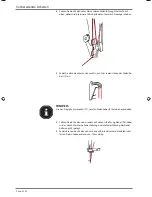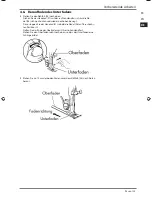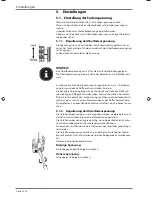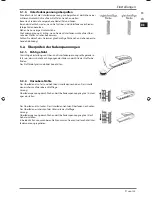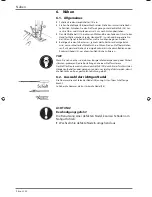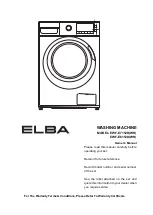
108 von 122
6.15. Sticken
6.15.1. Allgemeines
Entfernen Sie den Nähfuß und montieren Sie die Stopfplatte. Wählen Sie die
normale Unterfadenspannung.
Nähfuß: ............................................................................................................ohne Nähfuß
Programm: ............................................................................................................................ 1
Stichlänge: .................................................................................................................. 1 bis 4
Die Oberfadenspannung muss so locker eingestellt werden, dass der Unterfa-
den nicht auf die rechte Seite des Stoffen gezogen wird.
Spannen Sie den Stoff in den Stickrahmen (im Fachhandel erhältlich).
Senken Sie den Nähfußhalter (29), damit die Fadenspannung wirksam wird.
Halten Sie den Stickrahmen mit Ihrer Hand fest, während Sie das ge-
wünschte Muster nähen. Bewegen Sie nicht den Stoff, sondern immer den
Stickrahmen.
VORSICHT!
Verletzungsgefahr!
Ohne Nähfuß und Fingerschutz, besteht die Gefahr einer
Verletzung durch den direkten Zugriff auf den Nähmecha-
nismus.
Halten Sie die Finger immer außerhalb des Stickrahmes,
um Verletzungen zu vermeiden.
TIPP
Wir empfehlen Ihnen, das gewünschte Stickmuster auf der rechten Stoffseite
mit Bleistift oder Schneiderkreide (im Fachhandel erhältlich) aufzuzeichen.
6.16. Knöpfe und Ösen annähen
Setzen Sie die Stopfplatte auf den Transporteur, damit kein Strofftransport
erfolgt.
Nähfuß: ............................................................................................................ Standardfuß
Programm: .......................................................................................................................... 91
Stichbreite: .................................................................................................................. 2 bis 7
Lassen Sie den Nähfuß (28) herab und legen Sie dabei den Knopf so zwi-
schen Stoff und Nähfuß (28), dass der Zickzackstich in die Löcher des Knop-
fes trifft, wie auf der Abbildung zu sehen.
Kontrollieren Sie die richtige Lage des Knopfes durch Drehen des Hand-
rades (21) von Hand. Die Nadel (26) muss exakt in die Löcher des Knopfes
stechen, um eine Beschädigung der Nadel (26) zu vermeiden. Falls nötig,
ändern Sie die Breite des Zickzackstiches.
Nähen Sie mit niedriger Geschwindigkeit 6 bis 7 Stiche pro Loch.
Bei Knöpfen mit vier Löchern wird der Stoff mit dem Knopf verschoben: dann
werden auch in die anderen Löcher 6 bis 7 Stiche genäht. Nach dem Entfernen
des Stoffes bringen Sie den großzügig abgeschnittenen Oberfaden auf die Un-
terseite des Stoffes und verknüpfen ihn dort mit dem Unterfaden.
Nähen
17187 ES ALDI ES Content MSN 5005 3127 final.indb 108
17187 ES ALDI ES Content MSN 5005 3127 final.indb 108
18.05.2016 07:17:37
18.05.2016 07:17:37
Summary of Contents for MD 17187
Page 2: ...nes ual ung Bitte aufklappen Please fold out Abrir aquí ...
Page 6: ...28 23 24 25 26 27 31 32 29 30 Mecánica de coser Sewing mechanisms Nähmechanik ...
Page 8: ...11 Especificaciones técnicas 39 12 Pie de imprenta 39 13 Índice 40 Índice 2 de 122 ...
Page 48: ...11 Technical data 79 12 Legal notice 79 13 Index 80 Contents 42 of 122 ...
Page 88: ...11 Technische Daten 119 12 Impressum 120 13 Index 121 Inhaltsverzeichnis 82 von 122 ...
Page 128: ...122 von 122 Letzte Seite Index ...

